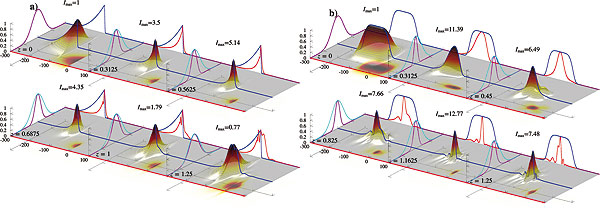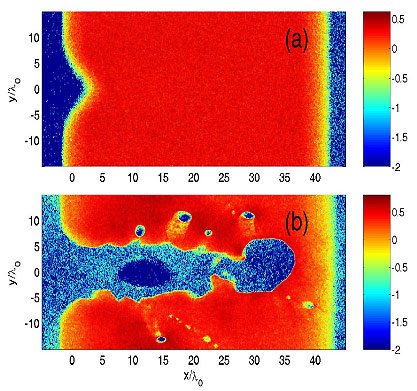Interaction
of strong electromagnetic radiation
with plasma
IAP researchers (A. G. Litvak, V. A. Mironov,
G. M. Fraiman, A. V. Kim, et al.) have recently performed an extensive research cycle in the field of the theory of nonlinear waves, which was focused primarily on laser physics applications.
In the presence of a strong laser field, the character of electron-ion collisions changes significantly. In the case of a long radius of high-frequency oscillations, electrons come back to ions repeatedly and undergo the focusing action of the Coulomb potential, which leads to a change in the scattering parameters. Unlike the conventional assumptions, the efficiency of Joule plasma heating is not attenuated with an increase in the intensity of the electromagnetic wave, since the frequency of electron-ion collisions decreases slower as the laser field amplitude E increases (E—2 instead of E—3). Additionally, coherent radiation is generated at the harmonics of the pump field, which depends weakly on the field polarization, and high-energy particles appear, whose energy distribution has a universal form for non-relativistic and relativistic intensities of the pump field.
The integral of coupled electron-ion collisions has been found, which describes all the aforesaid effects in strong electromagnetic fields. This allows one to take into account the effects of collisions within modern schemes which describe inertial controlled fusion.

Dynamics of intensity of a laser pulse for two different types of initial conditions: a — for a triangular pulse with the initial duration equal to 24 field periods and initial amplitude of 2.4 relativistic units; b — for a super-Gaussian laser pulse with the initial duration equal to 20 field periods and initial amplitude of 2 relativistic units. The blue line shows the initial time profile of the laser pulse at the beam axis; the red line shows the current time profile of the pulse at the beam axis; the light-blue line shows the initial distribution of the field intensity in the transverse direction; and the purple line shows the current distribution of the laser pulse in the transverse direction
The advance in new laser technologies used to generate optical femtosecond pulses inspired studies of the processes of shortening the pulses further. The following schemes of laser pulse compression in plasma have been proposed and developed at IAP:
- The possibility of amplification of ultrashort laser pulses during Raman backscattering in the plasma of a thin capillary or in a gas jet has been demonstrated experimentally and theoretically;
- It has been shown that as a high-power femtosecond laser pulse propagates in a gas-filled dielectric capillary, a new mechanism of ionization self-compression of the pulse can be realized, which is caused by formation of a nonlinear plasma waveguide, whose abnormal dispersion allows one to group the short-wave spectral components produced in the process of gas ionization. In the optimal regime, the proposed compression scheme makes it possible to obtain ultrashort pulses with durations of several field periods and energies of tens of kilovolts. This corresponds to a petawatt power level.
- New methods of self-compression of laser pulses up to one optical period of the field with a multi-PW power level, in which the mechanisms of laser pulse shortening are fundamentally related to the nonstationary nature of the laser pulse self-action under the conditions of excitation of a wake plasma wave.

Shape of the channel formed as a result of the action of a single Gaussian pulse (top) and a series of 10 Gaussian pulses (bottom) on the laser-produced plasma (the laser radiation wavelength is λ = 1 μm, the thickness of the plasma layer is 40 wavelengths, and the unperturbed density
is 2 critical values). The duration of the single pulse is 300 fs, and its maximum intensity is I = 4.3 Х 1019 W/cm2. The pulse series consists of pulses with durations of 30 fs each and
a pause of 60 fs between the pulses. The maximum intensity and the total energy is the same as in the case of the single pulse. The color shows the distribution of ion density on the logarithmic scale
In one of the schemes, pulse self-compression is achieved due to the nonstationary nature of self-focusing of a spatially confined laser pulse which has a duration shorter than the period of the plasma wave. In another scheme, a laser pulse having the duration, which coincides with the plasma wave period, self-compresses. The compression is caused by the specific features of conversion of the spectrum of a relativistically strong pulse in plasma, when the spectrum is transformed to the red region at the pulse front
(due to plasma displacement from the strong-field region), and at the pulse tail, the spectrum shifts primarily to the blue region, which leads to pulse compression with allowance for abnormal plasma dispersion.
The method of laser hole boring (LHB) is proposed for more efficient transfer of energy to particles in the schemes of fast ignition of inertial fusion. The method consists in formation of a channel in dense overcritical plasma under the action of relativistically strong laser radiation as a result of ponderomotive ejection of particles from the strong-field region. The use of this method is constrained by an insufficient velocity of the channel growth and evolution of instabilities, e.g., firehose instability, in the process of channel formation. It has been shown that it is possible to increase the efficiency of channel formation significantly and improve its quality by time-profiling laser pulses appropriately. This requires realization of a hybrid regime during interaction with plasma, in which the features of relativistically induced transparency manifest themselves. Numerical research has shown that the main factors, which determine how close the regime is to the relativistically induced transparency, are the steepness of the leading edge of a laser pulse and "splitting" of the laser energy, i.e., the use of a series of several short pulses with controlled pauses between them, rather than a single pulse.





